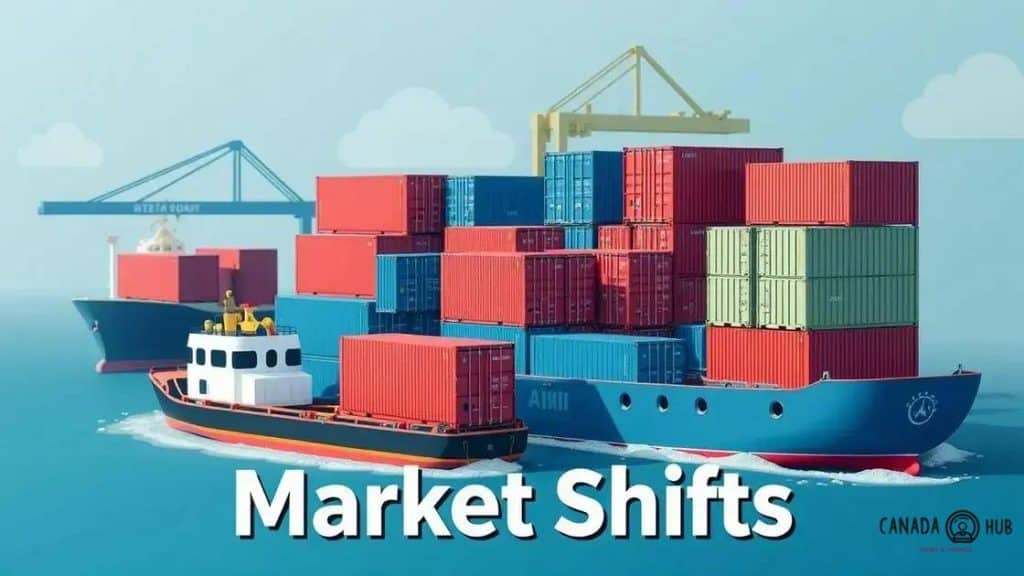Market shifts after major government tariff implementations

Market shifts after major government tariff implementations lead to increased prices, changes in consumer behavior, and adaptations in various sectors such as manufacturing, agriculture, and technology.
Market shifts after major government tariff implementations can significantly alter economic landscapes. Have you noticed how certain products suddenly feel more expensive? In this article, we’ll explore the intricate effects of these tariff policies on various industries.
Understanding the impact of tariffs on trade dynamics
Understanding the impact of tariffs on trade dynamics is crucial in today’s economy. Tariffs are taxes imposed by governments on imported goods, which can lead to significant changes in both local and international markets. As countries adjust these tariffs, the effects ripple through various industries, influencing prices, supply chains, and consumer behavior.
Why Tariffs Matter
Tariffs can alter the competitive landscape between domestic and foreign producers. When tariffs are raised on imports, domestic products often become more attractive to consumers seeking lower prices. This shift can support local industries but may also lead to higher prices for goods.
Key Effects of Tariffs
- Increased Costs: Consumers may face higher prices on imported products as tariffs increase production costs.
- Changes in Demand: As prices rise, consumer demand for imported goods may decrease, leading to shifting market dynamics.
- Impact on Supply Chains: Companies reliant on imported materials might need to adapt their supply chains, causing further disruptions.
Furthermore, tariffs can lead to retaliatory measures by affected nations, creating a cycle of increasing trade barriers. This retaliation can escalate into trade wars, which can significantly impact global markets. For example, when one country increases tariffs, others may respond in kind, resulting in a decrease in overall trade volume.
Real-world Implications
Consider the recent tariff increases between major economies. These have not only affected prices but have also forced companies to reassess their production strategies. In many cases, businesses have opted to relocate manufacturing to countries with lower tariffs, effectively reshaping their operational landscapes.
This dynamic environment emphasizes the importance of understanding tariffs and their broader implications. Overall, being informed about how tariffs influence trade can help businesses and consumers make better choices in a rapidly changing market.
Key sectors affected by recent tariff changes
Key sectors affected by recent tariff changes reveal much about the evolving landscape of international trade. Various industries react differently to tariffs, and understanding these impacts can help businesses and consumers navigate the market more effectively.
Manufacturing Industry
The manufacturing sector is often at the forefront of tariff discussions. Increased tariffs on imported raw materials have raised costs for manufacturers. This leads to higher product prices, which can reduce competitiveness in the global market.
Agriculture Sector
Agricultural products are significantly impacted by tariffs. Many farmers may face challenges when exporting goods abroad. When foreign countries impose tariffs on agricultural exports, it can limit market access and reduce income for farmers. In many cases, domestic farmers may benefit from reduced imports as it drives local consumption.
Technology Sector
The technology industry experiences shifts as tariffs affect supply chains. Companies that rely on imported components may see increased costs, forcing them to seek domestic alternatives or passing on costs to consumers. This can lead to shifts in innovation and production strategies as companies adapt to the new realities of trade.
- Cost Adjustments: Increased tariffs can drive up prices of tech products.
- Market Realignment: Companies may need to shift supply sources.
- Consumer Behavior: Higher prices could deter buyers.
Another notable sector is retail, where products often cross borders before reaching consumers. Retailers may experience narrowed profit margins as tariffs increase. The challenge lies in balancing price points with consumer expectations, creating pressure to innovate in sourcing and pricing strategies.
Transportation and logistics are also influenced by tariff changes. Shipping costs can rise as tariffs are applied, particularly on goods that travel long distances. Companies have to consider these changes in their logistics planning to maintain efficiency.
With such diverse impacts across sectors, tracking how these changes interact within the market is vital. By staying informed, businesses can pivot appropriately to succeed in a competitive environment.
Case studies: Real-world examples of market shifts
Case studies provide concrete examples that illustrate how market shifts occur in response to tariffs. Several businesses have faced significant changes due to recent government policies, allowing us to see firsthand the impact of tariffs on various industries.
Example 1: Steel Industry
In 2018, the U.S. imposed tariffs on imported steel, aiming to protect local producers. This led to an immediate increase in the price of steel products. Domestic steel manufacturers welcomed these tariffs, as they found it easier to compete against cheaper imports. However, construction companies faced higher costs, which they struggled to pass on to consumers. This shift in the steel market highlights the complexity of tariff impacts.
Example 2: Agricultural Products
Another notable case is the U.S. agricultural sector, particularly soybean farmers. After tariffs were imposed by China on U.S. soybeans, farmers experienced a significant drop in demand for their products. Many were forced to seek new markets or face reduced income. As a result, some farmers have diversified into other crops or adjusted their business strategies, reflecting the challenges posed by market shifts influenced by trade policies.
- Changes in Export Markets: Farmers explored alternative countries for exports.
- Business Adaptation: Many transitioned to different crop types to ensure profitability.
- Economic Strain: The uncertainty led to financial stress among farmers.
Additionally, the tech industry has seen its own shifts. Companies that rely on Chinese suppliers for components faced greater costs due to tariffs. In response, some tech firms relocated manufacturing operations to countries like Vietnam or Thailand, aiming to maintain competitive pricing. This change illustrates how companies adopt new strategies when tariffs create pressures in their supply chains.
As we can see, these case studies reflect real-world examples of how tariffs lead to unpredictable market shifts. Companies and consumers alike must adapt to these changes to thrive in an evolving economic landscape.
Consumer reactions to increased tariffs
Consumer reactions to increased tariffs can greatly influence market dynamics. When tariffs rise, consumers often notice price increases on imported goods. This effect tends to create a ripple in consumer behavior, as people adjust their purchasing habits based on new prices.
Price Sensitivity
Many consumers are price-sensitive, meaning that higher costs can change their buying choices. When the price of imported products increases due to tariffs, consumers may opt for cheaper alternatives. This shift can lead to a decline in demand for certain goods, pushing retailers to reevaluate their pricing strategies.
Preference for Local Products
Another common reaction is a newfound interest in local products. As imported goods become more expensive, consumers often turn to domestic alternatives. This behavior can be beneficial for local businesses, enabling them to gain market share. During such times, marketing locally produced items can resonate well with consumers.
- Support for Local Economies: Buying local helps strengthen community businesses.
- Increased Brand Loyalty: Consumers may feel a connection to local brands.
- Changing Consumption Patterns: A shift toward sustainability becomes more prevalent as consumers consider the environmental impact of imports.
Consumer sentiment can also reflect broader economic feelings. For instance, when tariffs are seen as protective measures, many support them, believing they safeguard jobs. However, if tariffs lead to significant price increases, discontent may grow. The public’s perception can shape how companies promote their products, focusing on value and quality.
Overall, as consumers adapt to the reality of increased tariffs, their reactions can drive significant shifts in the market. Understanding this behavior is essential for businesses aiming to thrive in a changing economic climate.
Future projections: Navigating a changing market landscape
Future projections for navigating a changing market landscape are essential for businesses and consumers alike. As tariffs continue to shape trade dynamics, it is vital to anticipate how these changes may impact various sectors.
Emerging Trends
One significant trend is the increase in domestic production. As tariffs on imports remain high, many companies may shift their focus to local manufacturing. This can lead to job creation and stimulate local economies. By investing in domestic production, businesses can minimize their reliance on international supply chains, which are often subject to tariff fluctuations.
Technological Innovations
Another area to watch is the rise of technological advancements. Companies are increasingly leveraging technology to enhance productivity and reduce costs. Automation and artificial intelligence can help streamline operations, making it easier to adapt to market shifts caused by tariffs. Embracing these innovations will be critical for maintaining competitiveness.
- Adapting Supply Chains: Businesses may look for alternatives to current supply sources to avoid tariff impacts.
- Diverse Sourcing: Companies can benefit by diversifying their suppliers to reduce risk.
- Focus on Sustainability: Many consumers favor eco-friendly practices, encouraging companies to adopt sustainable approaches.
Consumer behavior will also play a crucial role in shaping the market. As more people become aware of how tariffs affect prices, they may choose to support local goods. This shift can further encourage businesses to adapt their marketing strategies, emphasizing local products and sustainability.
Overall, staying informed about these future projections allows both businesses and consumers to navigate through the changes effectively. The ability to pivot and adapt will be vital in a landscape defined by ongoing tariff impacts and shifting market demands.
FAQ – Frequently Asked Questions about Market Shifts after Tariff Implementations
How do tariffs affect the prices of imported goods?
Tariffs increase the cost of importing goods, leading to higher prices for consumers and potentially shifting their buying behaviors.
What sectors are most impacted by tariff changes?
Sectors such as manufacturing, agriculture, and technology commonly face significant impacts as they adapt to fluctuating trade costs.
How can companies adapt to changes in consumer behavior due to tariffs?
Companies can adapt by focusing on local production, improving their marketing strategies, and emphasizing sustainability to meet changing consumer preferences.
What role does technology play in navigating tariff impacts?
Technology can enhance productivity and streamline operations, allowing businesses to reduce costs and remain competitive in a changing market landscape.





